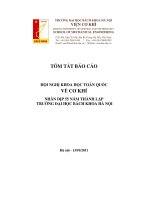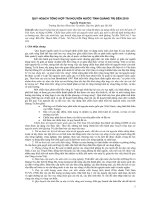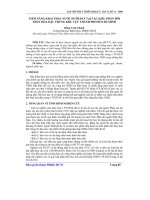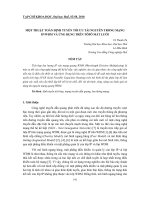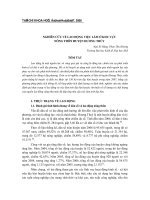Báo cáo nghiên cứu khoa học: "Nghiên cứu về tình hình sốt rét tại các xã biên giới huyện Hướng Hoá, tỉnh Quảng Trị năm 2010" pot
Bạn đang xem bản rút gọn của tài liệu. Xem và tải ngay bản đầy đủ của tài liệu tại đây (79.16 KB, 7 trang )
123
JOURNAL OF SCIENCE, Hue University, N
0
61, 2010
RESEARCH ON THE MALARIA SITUATION AT THE BORDER
COMMUNES IN HUONG HOA DISTRICT, QUANG TRI PROVINCE
IN THE YEAR 2010
Hoang Ha
Preventive medicine Center of Quang Tri
Nguyen Van Tap, Le Xuan Hung
College of Medicine and Pharmacy, Hue University
SUMMARY
Huong Hoa is a district with severe malaria in Quang Tri province. The district has 22
communes with 75,000 people. The resident population belongs to three ethnic groups who are:
Kinh, Pako, and Van kieu. Huong Hoa has 11 communes which border on neighboring nations,
three of which share a common border with Lao. The malaria situation is always fluctuant and
complicated due to mass migration there. We have conducted a malaria survey at 3 communes:
Thanh, Thuan, Xy with 2,082 residents. The incidence of malaria was 0.43% and the infectious
rate of parasites was 1.39%. There was no statistical difference among communes.
Key worlds: severe malaria, malaria case, parasite rate, border commune, ethnic group.
1. Introduction
Malaria is a common social infectious disease not only in Vietnam but also
throughout the world. According to the WHO in 1992 the malaria situation was very
serious and complicated. Annually, more than 100 million people were infected and
over one million died. A lot of epidemic outbreaks have occurred in Asia and Africa. In
Vietnam, a program of malaria eradication has been conducted since 1958, but at the
end of the 1970s- 1980s, due to a lack of resources, malaria has turned back. In 1991,
the whole of the country had 144 outbreaks with 1 million malaria cases, in which 4646
persons died. Since this time, Vietnam has changed strategy from malaria eradication to
disease control with 3 objectives:
- Reducing cases of malaria.
- Reducing mortality from malaria.
- Reducing the harmful effects of malaria.
An evaluation of the results conducted after ten years (1991-2000) showed that
in Quang tri, malaria cases were reduced by 73.15%; deaths due to malaria were
124
reduced by 96.8%; and outbreaks were reduced by 98.6%. Hence malaria was reduced
but the risk of the disease is threatening to turn back.
Huong hoa is a district with severe malaria. 22 communes of the district are
hyper - endemic areas, especially the 7 communes that share the border with Lao.
In 1989, the rate of parasites was 27%, but two years later (1990-1991) after
some methods were implemented, this rate was reduced about sevenfold (4.04%).
However, from 1993-2003 the malaria situation was still serious and complicated, and
outbreaks sometimes occurred at Thanh, Thuan communes.
Malaria cases in Huong hoa are always estimated to be approximately 50% of
the whole province. This problem is believed to be related to the mass migration of
people between border communes. Because of this we decide to conduct the study
“Research on the malaria situation at the border communes in Huong Hoa district,
Quang tri province, 2010.” This research has two objectives:
- To determine the rate of malaria cases and parasites at the three important
border communes in Huong Hoa 2010.
- To find out the factors relating to malaria.
2. Method:
2.1. Research subject:
All members in households at the selected villages.
2.2. Research site:
Three border communes: Thuan, Thanh, and Xy.
2.3. Research method:
Cross- sectional survey based on the regulations of the WHO (reference?)
2.4. Sample size:
Based on the formula
With: N: Size of sample, CI: 95%, Bias (d): 0,01
N= 1825 is the minimum size.
2.5. Sampling method: Randomly based on cluster sample.
2.6. Variables of epidemiology include:
2
2
)1()
2
1(
d
PPZ
N
125
- Incidence of malaria with age, gender, and place.
- Incidence of parasites with age, gender, and place.
- Structure of parasite: P.F, P.V, P.F+V
- Find out the relationship between malaria and different factors.
+ The relationship between malaria and age, gender and place.
+ The relationship between parasites and age, gender, and place.
2.7. Data analysis: Based on methods of medical statistics.
3. Results
3.1. Result of cross-sectional survey at 3 communes (Thuan, Thanh, and Xy)
in 2010
3.1.1. General information:
Total of population at three communes is 6576 person. Total of person were
surveyed is 2082.
Result: 2082 slides:
3.1.2. Result of epidemiology
3.1.2.1. Incidence of malaria
Table 3.1. Incidence of malaria cases per commune
No Communes
Malaria case No malaria case Total
No % No % No %
1 Thuận 5 0.71 695 99.29 700 100.00
2 Thanh 2 0.26 778 99.74 780 100.00
3 Xy 2 0.33 600 99.67 602 100.00
Total 9 0.43 2,073 99.57 2,082 100.00
3.1.2.2. Rate of parasites per commune.
Table 3.2. Incidence of parasites per commune
No Commune
Parasite No parasite Total
No % No % No %
1 Thuận 0 0.00 700 100.00 700 100.00
2 Thanh 13 1.67 767 98.33 780 100.00
126
3 Xy 16 2.66 586 97.34 602 100.00
Total 29 1.39 2,053 98.61 2,082 100.00
3.1.2.3. Structure of parasite at three communes
Table 3.3. Composition of parasites per commune
No Commune
P.falciparum P.Vivax Mix (P.F+P.V)
No % No % No %
1 Thuận 0 0.00 0 0.00 0 0.00
2 Thanh 1 7.69 12 92.31 0 0.00
3 Xy 9 56.25 6 37.50 1 6.25
Total 10 34.48 18 62.07 1 3.45
Remark: P Falciparum is 34.48%, P vivax is 65.52%, P F+ V : 3.45%; Vivax is
higher than Falci.
3.1.2.4. The rate of gametocyte based on communes
Table 3.4. The rate of gametocyte based on communes
No Commune
Gamatocyte No gamatocyte Total
No % No % No %
1 Thuận 0 0.00 0 0.00 0 0.00
2 Thanh 3 23.08 10 76.92 13 100.00
3 Xy 5 31.25 11 68.75 16 100.00
Total 8 27.59 21 72.41 29 100.00
3.2. Relative factors to malaria
3.2.1. The relationship between malaria and age
Table 3.5. The relationship between malaria and age
No Age group
Malaria No malaria
Total
Statistical
significance
No % No %
1 < 5 2 0.46 434 99.54 436
χ
2
= 2.35
P
= 0.30
2 5 – 14 1 0.14 708 99.86 709
3 >= 15 6 0.64 936 99.36 937
Total 9 0.43 2.073 99.57 2.082
127
Remark: No statistical difference on the rate of malaria among age groups
3.2.2. The relationship between parasites and age
Table 3.6. The relationship between parasites and age.
No Age group
Parasite No parasite
Total
Statistical
significance
No % No %
1 < 5 6 1.38 430 98.62 436
χ
2
=
9.08
P
= 0.01
2 5 – 14 17 2.40 692 97.60 709
3 >= 15 6 0.64 931 99.36 937
Total 29 1.39 2,053 98.61 2,082
Remark: The statistical difference on the rate of parasite among age groups
3.2.3. The relationship between malaria based on communes
Table 3.7. The relationship between malaria based on communes
No
Surveyed
commune
Malaria case No malaria case
Total
Statistical
significanc
e
No % No %
1 Thuận 5 0.71 695 99.29 700
χ
2
=
1.99
P
= 0.36
2 Thanh 2 0.26 778 99.74 780
3 Xy 2 0.33 600 99.67 602
Cộng 9 0.43 2,073 99.57 2,082
Remark: The statistical difference on the rate of parasite among age groups
3.2.4. The relationship between parasites based on communes
Table 3.8. The relationship between parasites based on communes
No commune
Positive Negative
Total
Statistical
significanc
e
Numbe
r
% Number %
1 Thuận 6 1.38 430 98.62 436
χ
2
=
17.33
P
= 0.0001
2 Thanh 17 2.40 692 97.60 709
3 Xy 6 0.64 931 99.36 937
Total 29 1.39 2,053 98.61 2,082
128
4. Discussion
From the results above, we have some discussions:
4.1. General situation:
Thanh, Thuan, and Xy are 3 border communes and hyper-endemic areas. The
communes have 2 ethnic groups: Pako and Van kieu. Most of the people have low
education and low living standards. The results of different authors showed that among
communes the rate of illiteracy is still high (48.7%). This is a challenge in the control of
malaria
4.2. Incidence of malaria:
This incidence is rather low (0.43%) compared with Hoang Ha’s research at the
Thanh commune- Huong Hoa - Quang tri 2001-2002 (6.13 %). There is no statistical
difference in the rate of malaria among age groups and among communes.
4.3. The rate of parasites:
In 1997, A cross - sectional survey was conducted by Quy Nhon Istitute of
Malaria which found parasitology and entomology were 7.42 %; and in Hoang Ha from
2001-2002 it was (9.1%) in 5 communes, this result is very low. The rate of parasites
among communes had no statistical significance. There is no statistical difference
between males and females, or among age groups.
Structure of parasites:
The results of positive slides at the three communes showed that P Fal
is.34.48. %, vivax is. 62.07.%. . A survey was conducted by IMPE of Quy nhon in Nam
Dong- Thua thien- Hue in 1997, which was the same (F: 75%; V: 25%). The structure of
parasites in this study was rather different.
5. Conclusion
5.1. Incidence of malaria:
- Among the three communes, the incidence of malaria is 0.43 %, the incidence
in Thuan commune was the highest (0.71%) and that of Thanh commune was the lowest
(0.26%)
5. 2. The rate of parasite:
- Among the three communes, the rate of parasites was 1.39%, Xy: 2.66%;
Thanh: 1.67%
- The composition of parasites was: P F 34.48.%; P Vivax. 62.07%
- The rate of gametocyte was: 27.59 %
Summary: The malaria situation at three communes in particular, and in Huong
129
Hoa district in general are still high and endemic. More research and interventions are
needed to continue to address this issue in the future.
REFERENCES
1. Ministry of Health. Guidelines for malaria diagnosis and treatment, established with
Decision No. 4605 dated November 24, 2009. 2009:4.
2. The report of results from 10 years malaria prevention in Quang Tri province (1991-
2000).
3. Le DC, Ten years repelling malaria and initially developing sustainable factors of
malaria prevention in Vietnam from 1991-2000. Hanoi Medical Publisher 2001:14-26.
4. Hoang H. The study of malaria situation and relative factors in Huong Hoa district,
Quang Tri province in two years 2001-2002 [Master’s thesis of Medicine] 2001: 24-75.
5. Le XH, Nguyen MH. Malaria and preventive strategy. Hanoi Medical Publisher 2002:
13-133.
6. Dinh TH. Lectures on epidemiological methodology. Hue Medical College, 1991:12 -
21, 96 - 101.
7. World Malaria Report 2005.
8. World Malaria Report 2008.
9. WHO. Malaria Vector Control and Personal Protection. Technical Report Series: 936.
10. Lwanga SK, Lemesows. Détermination de la taille dún échantillon dan les Etudes
Sanometriques. Organization mondiale de la sante. Geneve 1991: 29 - 32.


